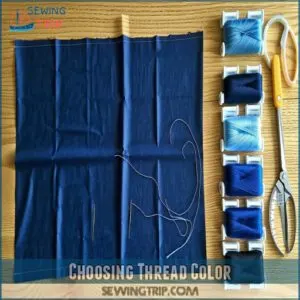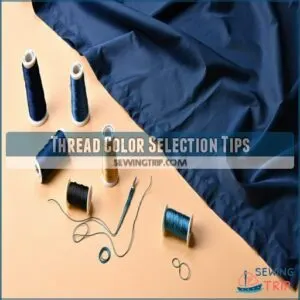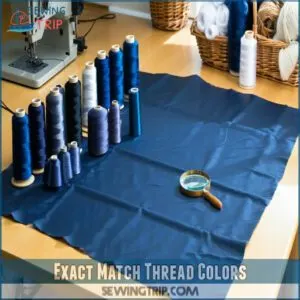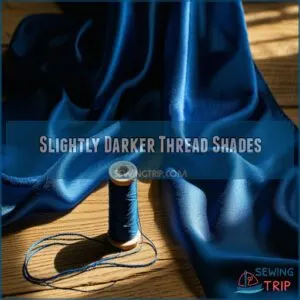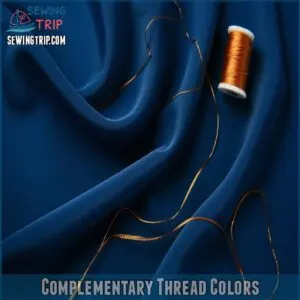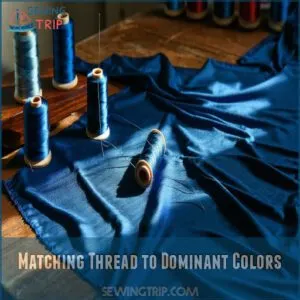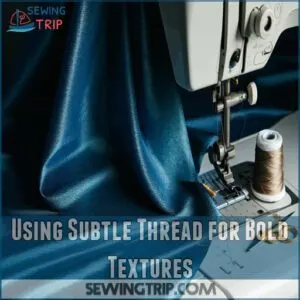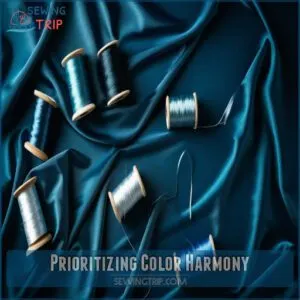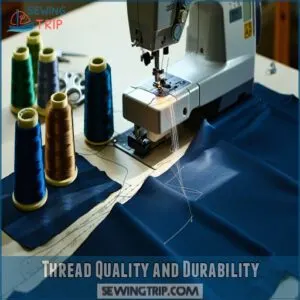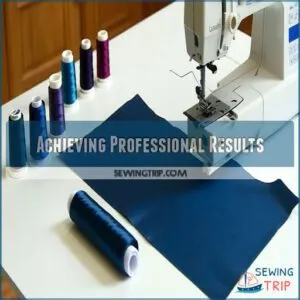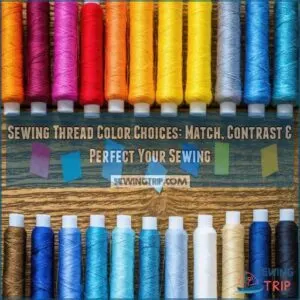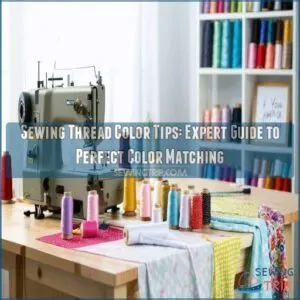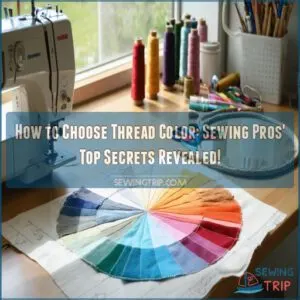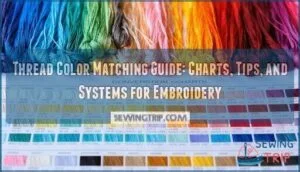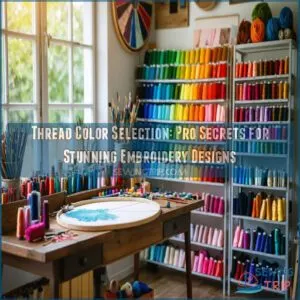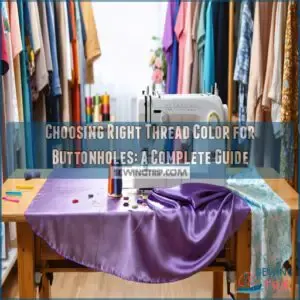This site is supported by our readers. We may earn a commission, at no cost to you, if you purchase through links.
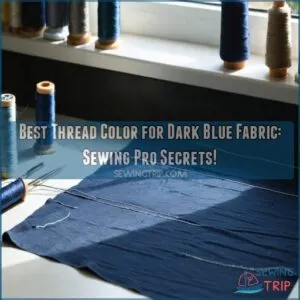 The best thread color for dark blue fabric depends on the look you’re going for.
The best thread color for dark blue fabric depends on the look you’re going for.
If you want invisible seams, stick with navy or a slightly darker blue—it blends seamlessly for a polished finish.
Need a bit of contrast? Try gray or even beige for a subtle pop without overwhelming the fabric.
Don’t forget to test the thread under different lighting; colors can shift depending on the light.
For bold patterns, match the thread to the fabric’s dominant color to keep things harmonious.
And always choose high-quality thread to avoid frustrating breaks.
Ready to elevate your sewing game? Let’s stitch smarter!
Table Of Contents
Key Takeaways
- Use navy or a slightly darker blue thread for invisible seams that blend perfectly with dark blue fabric.
- For a subtle contrast, go with gray or beige to add a pop without overpowering the fabric.
- Always test thread colors under different lighting to ensure they look right and match your fabric’s tone.
- Choose high-quality threads to prevent breaks and achieve a polished, professional finish.
Choosing Thread Color
Choosing the perfect thread color for your dark blue fabric can make or break your sewing project.
You’ll want to match your thread carefully, considering both exact color matches and slightly darker shades that’ll help your stitches blend seamlessly into the fabric, which is crucial for a visually appealing outcome with dark blue fabric.
Matching Dark Blue Fabric
When matching thread to dark blue fabric, you’ll want to nail that perfect color harmony.
Consider these key strategies:
- Select navy blue threads that mirror your fabric’s depth
- Choose slightly darker shades for seamless blending
- Test thread colors under different lighting conditions
Dark blue threads guarantee invisible seams, creating a professional finish that makes your sewing project look polished and precise.
Your fabric’s texture will thank you.
To achieve the best results, understanding thread shade selection is vital for a flawless finish, and this knowledge is key to ensuring your project has a professional finish.
Considering Contrast Options
When working with dark blue fabric, explore contrast options that’ll make your project pop.
Discover threads that create visual hierarchy by playing with shade variation and dark accent techniques.
Your thread choice can transform a simple piece into a standout design, balancing color relationships that catch the eye without overwhelming the fabric’s natural beauty, utilizing dark blue fabric effectively.
Using Neutral Thread Colors
When you’re stuck choosing thread for dark blue fabric, neutral tones are your secret weapon.
Neutral thread colors like gray, beige, and navy blend seamlessly with fabric shades, creating color harmony without stealing the spotlight.
They’re versatile lifesavers that help you match thread colors effortlessly, ensuring your sewing project looks professional and polished.
Thread Color Selection Tips
When working with dark blue fabric, choosing the right thread color can make or break your sewing project.
You’ll want to master a few key techniques that’ll help you select the perfect thread shade and achieve a professional, polished look.
This will ensure that your sewing project turns out well, and you’ll be able to notice the difference that the right thread color makes, with dark blue fabric.
Auditioning Thread Techniques
Ready to nail your thread color? Pro sewers have a secret weapon for thread auditioning that’ll transform your dark blue fabric project.
Here’s how to master thread color matching:
- Unwrap short thread lengths
- Lay threads across fabric
- Check under different lighting
- Compare shades side-by-side
Your fabric swatch is your best friend for shade matching – it’ll reveal the perfect thread that makes your stitches practically invisible.
Just like preparing for audition preparation, choosing the right thread color requires careful consideration and attention to detail, which is crucial for a successful outcome with thread auditioning.
Checking Thread Quality
Quality thread can make or break your sewing project—literally!
When checking dark blue sewing thread, perform a quick tensile test by gently pulling a strand to assess fiber strength.
Look for smooth, consistent texture without fraying or weak spots.
Check colorfastness by rubbing the thread against white fabric, ensuring no color transfer compromises your material durability.
Ensuring good sewing thread quality is essential for a successful sewing project, especially in terms of fiber strength and colorfastness.
Avoiding Visible Thread
After checking thread quality, hide your stitches like a pro with smart color blending techniques.
Choose thread that vanishes into dark blue fabric, creating invisible stitches that seamlessly integrate.
Match your thread to the fabric’s dominant hue or opt for a slightly darker shade.
Your goal is thread camouflage that makes seams look like they were sewn by magic.
Dark Blue Fabric Thread Options
When working with dark blue fabric, selecting the right thread color can make or break your sewing project’s professional look.
You’ll want to choose thread that either matches your fabric exactly or opts for a slightly darker shade to create seamless, polished stitches.
Exact Match Thread Colors
Often, finding an exact thread match for dark blue fabric feels like searching for a needle in a haystack.
Fabric stores offer a rainbow of color options, but matching navy thread can be tricky.
Pro tip: Bring your fabric swatch and compare thread shades under different lighting to nail that perfect color match for your dark blue project.
Understanding navy thread colors is essential to achieve a professional-looking finish on your sewing projects, and it involves considering the right thread match.
Slightly Darker Thread Shades
A thread’s subtle shade can make or break your sewing project, especially with dark blue fabric.
When exact matches elude you, darker hues are your secret weapon:
- Blend seamlessly into seams
- Hide imperfections effectively
- Create a polished, professional finish
Slightly darker navy or charcoal threads work magic, camouflaging stitches while maintaining your design’s integrity.
Trust your eye and test before committing.
For the best results, understanding dark blue thread options is key to achieve a flawless finish.
Complementary Thread Colors
Wondering how to make your dark blue fabric pop?
Complementary colors can be your secret weapon, think orange or golden yellow to create stunning thread contrast that breathes life into your project.
By understanding blue’s color wheel opposite, you’ll discover designer-level thread choices that add depth and visual interest without overwhelming your fabric’s beautiful blue undertones.
Considering Fabric Pattern
When choosing thread for your dark blue fabric, you’ll want to match the thread color to the dominant pattern colors or use a subtle shade that complements the fabric’s texture.
By prioritizing color harmony and carefully selecting your thread, you’ll create a professional-looking finish that enhances the overall appearance of your sewing project.
Matching Thread to Dominant Colors
When working with dark blue fabric, your thread color can make or break the final look.
Match your thread to the dominant color—typically the background shade—for seamless blending.
Pro tip: Choose a slightly darker thread that’ll hide stitches like a ninja. If you’re dealing with a patterned blue fabric, pick the most prominent color to guarantee thread color harmony and professional-looking results.
Using Subtle Thread for Bold Textures
A fabric’s bold texture demands a strategic thread approach.
When working with eye-catching surfaces, your thread choice can make or break the project.
Consider these subtle stitching secrets:
- Select threads that whisper, not shout
- Match thread weight to fabric complexity
- Use low-contrast colors for seamless integration
Understanding the importance of thread selection basics is essential for achieving a professional finish.
Blending your thread means understanding how texture plays with color, creating a professional finish that lets the fabric’s character shine through.
Prioritizing Color Harmony
After working with bold textures, your next move is mastering color harmony like a pro.
Think of thread selection as painting – each choice impacts the overall aesthetic.
| Color Theory | Tone Balance | Shade Selection |
|---|---|---|
| Hue Approach | Saturation Control | Contrast Management |
| Complementary | Analogous | Neutral Strategies |
Your thread isn’t just a functional detail; it’s your artistic signature, blending seamlessly with dark blue fabric’s personality.
Thread Quality and Durability
You’ll want to pay attention to thread quality, as it’s the secret weapon for creating long-lasting, professional-looking projects on dark blue fabric.
Choosing high-quality thread that’s fresh and strong will prevent frustrating breaks and guarantee your stitches stay put, no matter how much wear and tear your project encounters.
Factors Affecting Thread Color Consistency
When color shifts sneak up on your sewing project, you’ll want to master the art of thread color consistency.
Check for dye lot variations, inspect fabric under different lighting, and compare thread shades carefully.
A thread color chart can be your secret weapon against unexpected shade variations and tint differences that could derail your dark fabric masterpiece.
Importance of High-Quality Thread
Your thread’s durability isn’t just a detail – it’s a game-changer for your sewing projects.
Quality threads can make or break your final product, so pay attention to these key markers: Proper thread selection and fabric compatibility are vital for successful sewing.
- Fiber strength determines long-lasting seams
- Colorfastness prevents disappointing fading
- Tensile testing reveals true thread resilience
- Yarn quality impacts overall stitch integrity
- Consistent thread performance guarantees professional results
Avoiding Old or Low-Quality Thread
Beware of those dusty thread spools lurking in your craft drawer.
Old threads can sabotage your sewing project faster than you’d imagine.
Check for brittleness, uneven texture, and discoloration, and perform a quick yarn strength test by gently pulling the thread.
When in doubt, toss it out, because your dark blue fabric deserves fresh, reliable thread that won’t let you down.
Achieving Professional Results
When sewing dark blue fabric, you’ll want to choose the right thread color to guarantee a professional and polished finish.
Learn how to match, contrast, and select threads that’ll make your project seem like it was crafted by a seasoned pro.
Maintaining Thread Color Consistency
If you want your sewing project to look professional, you’ll need to nail down color stability across your entire piece.
Check each spool’s dye lot carefully to prevent unexpected color shifts when working with blue thread on dark fabrics.
Maintaining consistent thread colors means comparing spools under good lighting and selecting from the same manufacturing batch to avoid fabric shading variations.
Using Invisible Thread for Quilting
After perfecting your thread consistency game, you’ll want to master invisible thread for seamless stitching.
These near-transparent threads blend like magic on dark blue fabrics, creating fabric camouflage that’ll make your quilting look professional.
Pro tip: choose nylon or polyester invisible threads that match your blue fabric’s tone, ensuring those quilting techniques produce invisible seams that wow.
To achieve professional results, understanding the properties of invisible thread is essential for selecting the right thread for your project.
Selecting Thread for Specific Effects
If you’re aiming for specific effects, think about how thread blending or contrast thread blue impacts sewing visibility.
For subtle stitch camouflage, slightly darker shades or invisible thread blue work wonders.
Want boldness? Use complementary colors to pop against dark fabrics.
Matching thread colors guarantees color harmony, while textured fabrics benefit from threads that don’t overpower.
Frequently Asked Questions (FAQs)
How do I Choose threads for multi-colored fabrics?
Did you know 80% of sewing success depends on thread choice?
For multi-colored fabrics, match the dominant background color or a prominent hue.
Test threads on fabric under good light to guarantee harmony.
What color thread should I use for sewing?
Pick a thread that matches your fabric’s base color—slightly darker works best for blending.
For contrast or topstitching, go lighter or complementary.
Always test by laying thread on fabric under good lighting.
How do I choose the best thread color for piecing & sewing?
Go for a thread that blends with your fabric’s base color—slightly darker works best for hiding stitches.
Bring a swatch to match closely, or try neutral tones like navy or gray for versatility.
Does thread color need to match the fabric color?
Think of thread as the sidekick to your fabric’s hero.
It doesn’t always need to match exactly but should blend well or complement the design.
Slightly darker shades often hide stitches better for a seamless look.
What color thread should I use on a printed shirt?
Go with a thread that matches the shirt’s background color for a seamless look.
For bold prints, match a dominant color or use a neutral shade like gray or navy to keep things balanced.
How do I choose a fabric color match?
Bring a fabric swatch to the store and compare thread options directly.
Match the background color or go slightly darker for blending.
If unsure, neutral shades like navy or gray often work seamlessly.
Should thread be lighter or darker than fabric?
Darker thread delivers better blending, while lighter thread stands out more.
For a seamless look, go slightly darker than your fabric.
It hides stitches better, like a shadow, making imperfections nearly invisible.
How do you pick the color of thread?
Matching thread to fabric is like finding a dance partner—it should complement, not clash.
Lay thread across your fabric, test under good lighting, and aim for a shade slightly darker for seamless blending.
What color thread goes with everything?
Did you know neutral threads like gray, beige, or navy work with almost any fabric?
They’re your sewing secret weapon, blending effortlessly without stealing the spotlight.
Keep these shades handy for stress-free, versatile stitching.
How would you choose the appropriate color of the thread?
Choosing the right thread color is easy: compare short lengths against your fabric in natural light.
Aim for a slightly darker shade to blend seamlessly.
For bold designs, contrasts like complementary colors can work beautifully.
Conclusion
Don’t overthink it—choosing the best thread color for dark blue fabric is simpler than it seems.
If you’re after seamless blending, stick to navy or a slightly darker blue.
Want contrast? Try gray or beige for subtle flair.
Always audition thread in different lighting and prioritize high-quality options to avoid breaks.
Matching thread to dominant fabric colors guarantees harmony, especially with bold patterns.
With these tips, you’re set to stitch like a pro!
- https://www.threadsmagazine.com/2020/05/15/dont-match-your-thread
- https://stonemountainfabric.com/behind-the-scenes-thread-matching/
- https://auribuzz.com/2016/05/10/thread-matters-choosing-the-right-color/
- https://www.thesprucecrafts.com/choose-sewing-thread-color-type-and-fibers-2978366
- https://www.reddit.com/r/sewing/comments/xdk0z8/what_color_thread_to_use_with_this_fabricblue_or/

